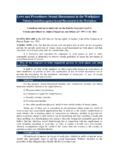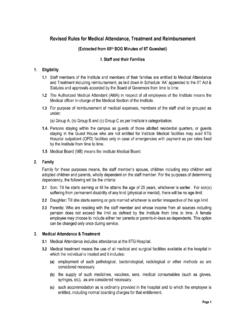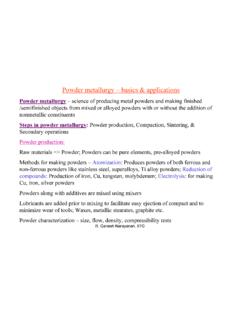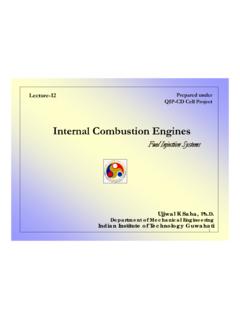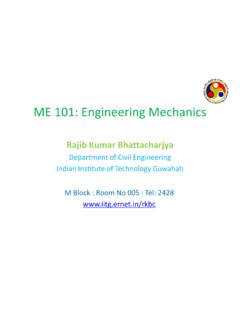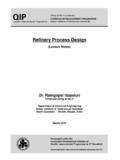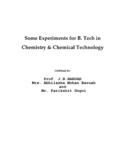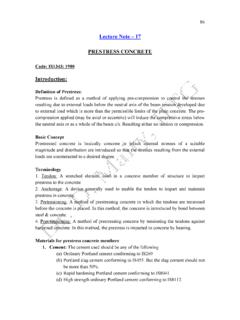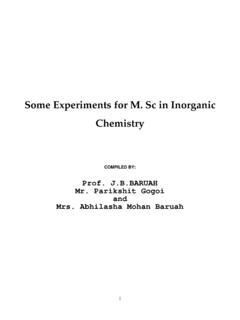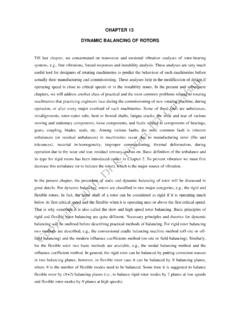Transcription of CHAPTER 6 TORSIONAL VIBRATIONS OF ROTORS …
1 CHAPTER 6 TORSIONAL VIBRATIONS OF ROTORS -I: THE DIRECT AND TRANSFER MATRIX METHODS In previous chapters, mainly we studied transverse VIBRATIONS of simple rotor-bearing systems. It was pointed out that transverse VIBRATIONS are very common in rotor systems due residual unbalances, which is the most inherent fault in a rotor. We studied behaviour of rotor due to speed-independent bearing dynamic parameters. Effect of gyroscopic couples on natural whirl frequencies is also investigated in details.
2 In the present CHAPTER , we will extend the analysis of simple ROTORS to TORSIONAL VIBRATIONS . We will start with the analysis of TORSIONAL VIBRATIONS of the single disc rotor, two disc rotor, and three disc rotor systems with the conversional Newton s second law of motion or energy methods. The analysis is extended to the stepped shafts, geared systems, and branched systems. For the multi-DOF system a general procedure of the transfer matrix method (TMM) is discussed for both undamped and damped cases.
3 Advantages and disadvantages of the TMM are outlined. In reciprocating engines large variations of torque take place, however, periodically. This leads to TORSIONAL resonances, and to analyse free and forced VIBRATIONS of these system a procedure is outline to convert them to an equivalent multi-DOF rotor system, which is relatively easier to analyse. The present CHAPTER will pave the road for the TMM to be extended for the transverse VIBRATIONS of multi-DOF rotor systems in subsequent chapters.
4 The study of TORSIONAL vibration of ROTORS is very important especially in applications where high power transmission and high speed are present. TORSIONAL VIBRATIONS are predominant whenever there are large discs on relatively thin shafts ( , the flywheel of a punch press). TORSIONAL VIBRATIONS may original from the following forcings (i) inertia forces of reciprocating mechanisms ( , due to pistons in IC engines), (ii) impulsive loads occurring during a normal machine cycle ( , during operations of a punch press), (iii) shock loads applied to electrical machinery (such as a generator line fault followed by fault removal and automatic closure), (iv) torques related to gear mesh frequencies, the turbine blade and compressor fan passing frequencies, etc.
5 ; and (v) a rotor rubs with the stator. For machines having massive ROTORS and flexible shafts (where system natural frequencies of TORSIONAL VIBRATIONS may be close to, or within, the source frequency range during normal operation) TORSIONAL VIBRATIONS constitute a potential design problem area. In such cases designers should ensure the accurate prediction of machine TORSIONAL frequencies, and frequencies of any TORSIONAL load fluctuations should not coincide with TORSIONAL natural frequencies.
6 Hence, determination of TORSIONAL natural frequencies of the rotor system is very important and in the present CHAPTER we shall deal with it in great detail. 272 A Simple Rotor System with a Single Disc Mass Consider a rotor system as shown Figure (a). The shaft is considered as mass-less and it provides TORSIONAL stiffness. The disc is considered as rigid and has no flexibility. If an initial disturbance is given to the disc in the TORSIONAL mode (about its longitudinal or polar axis) and allow it to oscillate its own, it will execute free VIBRATIONS .
7 Figure shows that rotor is spinning with a nominal speed of and executing TORSIONAL VIBRATIONS , z(t), due to this it has actual speed of ( )zt + . It should be noted that the spinning speed, , remains the same, however, the angular velocity due to torsion have varying direction over a period. In actual practice if we tune a stroboscope (it is a speed/frequency measuring instrument, refer CHAPTER 15) flashing frequency to the nominal speed of a rotor then free TORSIONAL oscillations could be observed.
8 For the present case and in most of our analysis, it is assumed that TORSIONAL natural frequency does not depend upon the spin speed of rotor. Hence, in limiting case when the spin speed is zero the natural frequency of the non-spinning rotor will be same as at any other speed. The free oscillation will be simple harmonic motion with a unique frequency, which is called the TORSIONAL natural frequency of the rotor system. Figure (a) A single-mass cantilever rotor system (b) A free body diagram of the disc Figure TORSIONAL VIBRATIONS of a spinning rotor 273 From the theory of torsion of the shaft (Timoshenko and Young, 1968), we have tzTGJkl == with 432Jd = ( )
9 Where kt is the TORSIONAL stiffness of shaft, Ip is the polar mass moment of inertia of the disc, J is the polar second moment of area of the shaft cross-section, l is the length of the shaft, d is the diameter of the shaft, and z is the angular displacement of the disc (the counter clockwise direction is assumed as the positive direction). From the free body diagram of the disc as shown in Figure (b), we have External torque of disc ztzzppkII == ( ) where represents the summation operator. Equation ( ) is the equation of motion of the disc for free TORSIONAL VIBRATIONS .
10 The free (or natural) vibration has a simple harmonic motion (SHM). For SHM of the disc, we have ( )sinzznft t = so that 22sinznfznfnfz t = = ( ) where z is the amplitude of the TORSIONAL vibration , and nf is the TORSIONAL natural frequency. On substituting equation ( ) into equation ( ), we get ()2tzpnfzkI = or ()20znfptIk = ( ) Since 0z , it gives tnfppkGJIlI == ( ) which is similar to the case of single-DOF spring-mass system in where the polar mass moment of inertia and the TORSIONAL stiffness replace the mass and the spring stiffness, respectively.
